In terms of streets, there are two things which get people het up in local communities - car parking and trees. I've talked a lot about the former in the past and so this week, I'm going to have a crack at the latter.
I guarantee that this post will raise all sort disagreement because it often turns into a very emotive subject - the fact of the matter is that people love trees and anyone taking a different view is looked upon with suspicion.
From the outset, I admit that I am not an expert in trees themselves and so I will be coming at the subject from more of a highway engineer's point of view and so there will be people with expert views from other angles. What I will say is I like trees, but this doesn't necessarily mean I always like the placing, species and management of them in our streets, so bear with me.
Street trees planted with a vision for the future.
From a walking and cycling point of view, trees definitely add something to the street if appropriately deployed. For walking, one could say they add "shade and shelter" plus "things to see and do" if we come at it from the Healthy Streets Approach and they make the environment attractive from a cycling point of view if we are looking at the "Five Principles".
On a dull morning in winter, the trees are adding something to the skyline.
My main controversial opinion is, however, that trees should take their place as a component in the kit of parts which we use and that extends to them having a "design life" like paving, lighting and the other "kit" we install, as well as sometimes being in the way. That's probably quite a dispassionate take, but people are often surprised that trees grow, they shed leaves (plus twigs, fruit etc), sprout side growth plus their roots can cause damage to paving and utilities.
A shared-use path next to a 50mph dual carriageway.
This is the state of annual growth from the base of a line of trees and bushes.
Today's small tree will become the next generation's perfectly proportioned street tree, but maybe the generation after that's maintenance nightmare. That's an important lesson really; we should be providing the right tree in the right place with the right management regime. Some trees will take much longer than the lifespan of a person to reach their full glory and so for any scheme involving removing or planting trees, getting advice from experts is a must if we are to leave the right legacy for those following us.
A lack of care means a poorly growing tree and potential utility damage.
A local example for me is the London Plane, a species I dislike for two reasons. First, they set off my hayfever and second (and maybe more significantly), they can become huge at over 30 metres in height which is around 9 storeys (if we take a standard 3.2 metres for a storey) and the size of their trunks and canopies can be significant.
The London Plane is an import and they were a popular tree in the 18th Century, which means some venerable specimens can be found today. The problem that pops up with the London Plane when we try and reconfigure our streets is they are often in the way and immediately, they become a focus of campaigns to stop whatever is being proposed. Of course, this could apply to any tree, in any street!
Temporary C9 scheme. The now removed tree (I think) is highlighted in red.
For example, trees were removed as part of the scheme to make the C9 cycleway permanent in Chiswick, West London. This act certainly got ripples of disapproval from those against the cycle scheme as well as those simply mourning the tree's loss. We can debate the detail because the removal allowed reinstatement of a traffic lane lost to the temporary scheme, but ultimately decisions were taken to try and deal with issues as they are today. Yes, replacements will be planted, but there is a community loss to street.
Sometimes it's easy to work with what we already have, but sometimes what we have forces a compromise. The cycle track in the photograph below is on Main Road, Romford. It would be far better with the trees and track swapped in terms of the feeling of protection, but politically, the wholesale removal of trees (even thought they would be replaced) was a step too far.
Sometimes we might use trees as part of a filtering scheme. On the one hand, it is nice to add trees to space reclaimed from motors and on the other (and don't say this too loud), trees might attract more future resistance to removal in the future than a couple of bollards such is the emotions they generate. The photograph below probably takes this to its conclusion as part of this filter in Leicester!
So look. Trees have an important place in the street, but they can be a burden, they can be an opportunity and they can lead to compromise. We really need to be honest and realistic about this and also recognise the emotion behind the subject. Speaking of which, even national politics gets on on the act.
The Westminster government has talked extensively about pushing the planting of street trees in new and existing developments, although the actual planning reforms that keep being promised seem to change week by week. Frankly, politicians wanting to plant lots of trees is as routine as saying they'll deal with potholes - it's an easy thing to say.
The Building Better, Building Beautiful Commission covers this in its Living With Beauty report. Personally, I find some of this report a bit pompous and preachy (there's a whole separate discussion around what constitutes "beauty"), but it does recognise the decline of trees being planted which has links to the inability of local authorities to afford long term maintenance.
A development with landscaping which remains privately maintained.
The report also talks about the need for better placemaking education and skills as well as calling for a longer term plan to bring trees back to our streets with proper investment. It recognises that the coordination of trees and utilities can be poor and yes, some highway authority engineers are risk adverse to adding street trees. Personally, I think that's a actually a proxy for the lack of maintenance budgets, lack of knowledge around how trees can be added and probably a good measure of being under pressure more generally.
From a practical point of view, many developments provide the bare minimum of space for decent landscaping. This is partly driven by the reluctance of local authorities to adopt landscaping and developers wanting to maximise building footprint. However, much older developments share a common problem and that's where can trees be planted within limited highway space.
It is often the case that trees are planted on the kerbside of footways and in some cases, the preparation work is incredibly basic which doesn't give a great chance for the trees to have a long life. Beyond that though, useable footway space is impacted which works against us trying to make places attractive to walk.
The sketch above shows a footway with trees planted on the kerbside. The pinkish area is the width of the footway sterilised by the trees and the buff is the area available for walking. The footway is 2 metres wide (plus the kerb width) and the trees are about 0.5 metres back from the kerb which keeps trunks and branches back from wing mirrors and handlebars (it's also worth noting that with steeper cambers and larger vehicles, this offset keeps vehicle bodies and the trees apart).
Inclusive Mobility talks about having a basic footway width of 2 metres as "the minimum that should be provided, as this allows enough space for two wheelchair users to pass" (1.8m is often used as a legacy of 6 feet being used in the pre-metric days). It's not just having an ability for people to pass, walking is sociable, and so 2 metres is a good basic width for people to walk side by side.
The photograph above shows people walking side by side and the red line shows a 2 metre width as it's hard to visualise the space. Where there is a building or a wall to the back of a footway, people tend to move out from it so they don't catch their arm or hand and on the traffic side, they tend to keep away from the kerb (known as "kerb shyness"). Inclusive Mobility gives 1.5 metres as the minimum width for a footway, but it is squeezing people.
An extreme example of trees blocking a footway from @Hackneycyclist
For many existing situations we might take the view that squeezing people to 1.5 metres every so often is OK if we can get trees in (although trunks do get larger over time - see above), but once actual flows of people increase in both directions, the space becomes eroded too much and we need to look to the carriageway.
Once we get into the carriageway, we have to consider the risk of someone driving into a tree given the quality of driving skills that some people have, although the risk in my view is often overstated.
The photograph above is of a street in Salford. The area is a low traffic, low speed situation and the tree on the right is actually in a little build out keeping the footway completely clear. The large tree and the build out provides a little bit of a contribution to a message that this is a street to drive slowly along.
New developments give an opportunity to integrate trees into the street. The photograph below is Barking Riverside where trees break up a line of parked cars with a completely clear footway. The tree pits are perhaps small, but in this case the road surface is permeable which allows water and air to access the tree roots which is important for tree health.
We can also retrofit existing streets in this way. The photograph below is from Cardiff where a sustainable drainage scheme includes additional tree planting. The trees in the centre were existing historic and in an odd central reserve in the residential street, but the trees in the build outs on both sides of the street are in what used to be carriageway.
I'd argue that we can go with something very simple in low traffic and low speed situations - 20mph Zones and the rules around traffic calming really work together to make planting trees in carriageways attractive. The sketch below shows a possible arrangement with the trees being protected by bollards. Once they reach a certain size, they are going to be quite resistant to low speed impacts anyway.
If we pushed on this kind of idea as part of an overall traffic reduction plan, we could gradually infill the space with more landscaping, drainage features, cycle parking (below) and so on. Yes, planting in the carriageway will be more expensive up front as a greater depth of road construction needs removing compared with footways, plus we need to take care with the positions of drains and sewers, but it could be a great investment.
Trees in the carriageway with cycle parking in Lambeth.
I have mentioned it in passing, but the other practical consideration is the presence and impacts from utilities (both above and below ground). The image below is an extract from "guidelines on the positioning and colour coding of underground apparatus" (pdf), which sets out the recommended position and depth of utilities in a "standard" 2 metre footway. The adherence to this is more likely on newer streets, but it at least demonstrates the space challenges we have in finding a gap within which to plant trees in footways. For new build schemes, there is definitely the need to coordinate trees with utilities.
Tree roots can damage utility pipes and chambers and so care should be taken in placing trees anywhere in the highway. I would say it's good practice for local authorities to get a planting strategy together with includes discussion with utility owners. It also needs to be recognised that people excavating in the highway need to be trained and supervised by a qualified and competent person.
Above ground, we have street lighting and utility poles/ cables. Street lighting placed next to trees creates shadows and this is often ignored when planting new trees and it is a challenge where lighting is being fitted into existing streets. Telecommunications and power cables can be found in streets and so trees can catch wires and cables as they grow causing damage.
A tree planted with a section of footway surface removed. The black pipe is for early years irrigation to the roots as well as providing a pathway for oxygen to get to the roots.
Trees in streets is a wonderful concept, but it is far more complex than breaking out a bit of asphalt and plonking in a tree. They are living organisms which have needs to be considered and designed in. The photograph above is a very basic installation which in the long term, may not work very well with surrounding soil potentially unsuitable and certainly compacted.
Here is a paper by Thomas O. Perry on tree roots as recommended by Prosocial Place. This includes some interesting discussion on how roots seek out oxygen through cracks and crevices which is an issue when you consider how little permeable surface is left over many urban trees. There are tree pit solutions available which give better outcomes in establishing trees, but the overall design needs to take into consideration the local soil, its compaction (often heavily compacted in urban areas), how the tree is to be watered in its early life and where roots will end up in both support terms and to minimise the risk to the highway and adjacent property.
A new development in Cambridge. The trees are probably a little close together, but at least there is a some space for them to grow as well as taking in water and oxygen through the unpaved area.
This all goes back to the point I made earlier. Adding trees to our streets requires the input from several disciplines and they very much need "designing" in terms of species, position, treatment and maintenance. Providing street trees is a technical process which perhaps lacks the romance that many people associate trees with. Of course, you can go and find that in a forest or woodland!




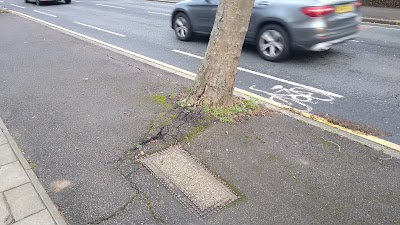
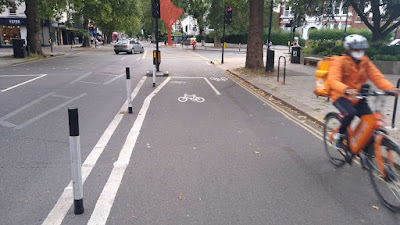

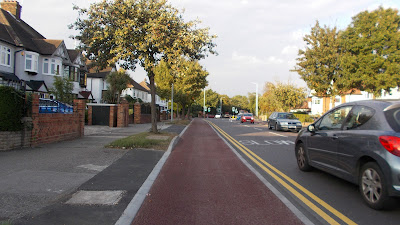



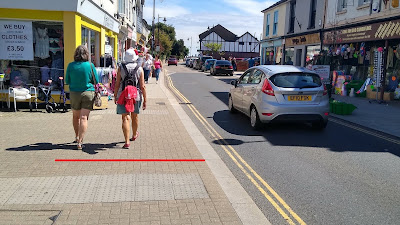
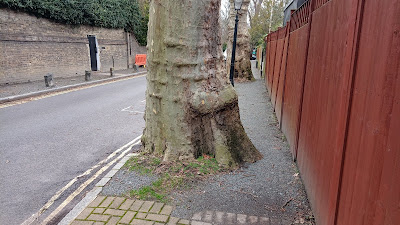
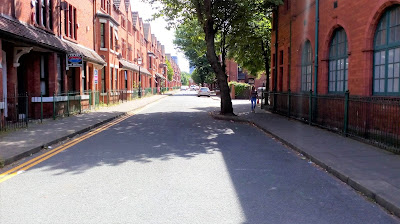








Excellent blog on this subject. A couple of points worth adding. The idea 'trees should take their place as a component in the kit of parts' is a common one and perhaps part of the problem we now face in the urban landscape. Our towns and cities are relatively young, and the extent of sealed streetscape, volume of vehicles and underground services has created a very congested/contested and hostile space for trees. We need to rethink trees from a design perspective, and look at them strategically and as a layer to places rather than part of the kit. The blog presents the argument for this well - buildings and the movement of people change over time, but the public realm space endures for centuries - we need to design with trees in this context if we are to maintain a healthy and sustainable urban forest.
ReplyDeleteAbsolutely, although I think we need to recognise that sometimes a tree does end up in the wrong place and it shouldn't be so controversial to remove them. Maybe the Dutch can teach us - they have nurseries full of very large trees because they plan for complete rebuilds of streets and places.
Delete